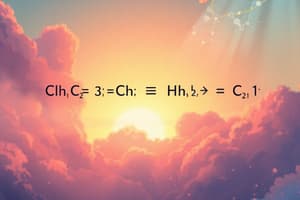Podcast
Questions and Answers
What is the purpose of the arrow in a chemical equation?
What is the purpose of the arrow in a chemical equation?
- To indicate the physical state of the substances
- To indicate the direction of the reaction (correct)
- To indicate the reactants
- To indicate the mole ratio of reactants and products
What type of reaction involves the combination of two or more substances to form a new compound?
What type of reaction involves the combination of two or more substances to form a new compound?
- Decomposition reaction
- Replacement reaction
- Synthesis reaction (correct)
- Combustion reaction
What is the principle that guides the balancing of a chemical equation?
What is the principle that guides the balancing of a chemical equation?
- Law of Multiple Proportions
- Law of Definite Proportions
- Law of Conservation of Energy
- Law of Conservation of Mass (correct)
What is the term for the ratio of the number of moles of reactants to the number of moles of products?
What is the term for the ratio of the number of moles of reactants to the number of moles of products?
What is the term for the reactant that is completely consumed during the reaction?
What is the term for the reactant that is completely consumed during the reaction?
What is the purpose of coefficients in a chemical equation?
What is the purpose of coefficients in a chemical equation?
What type of reaction involves the exchange of partners between two compounds, forming two new compounds?
What type of reaction involves the exchange of partners between two compounds, forming two new compounds?
What is the term for the physical state of a substance in a chemical equation?
What is the term for the physical state of a substance in a chemical equation?
Flashcards are hidden until you start studying
Study Notes
Chemical Equation
A chemical equation is a symbolic representation of a chemical reaction, using chemical formulas and symbols to illustrate the reactants, products, and direction of the reaction.
Components of a Chemical Equation
- Reactants: substances that undergo a chemical change, written on the left side of the equation
- Products: substances formed as a result of the chemical change, written on the right side of the equation
- Arrow: indicates the direction of the reaction, pointing from reactants to products
- Coefficients: numbers in front of formulas to indicate the mole ratio of reactants and products
- State symbols: indicate the physical state of each substance (e.g., solid (s), liquid (l), gas (g), aqueous (aq))
Types of Chemical Reactions
- Synthesis reaction: two or more substances combine to form a new compound
- Decomposition reaction: a single substance breaks down into two or more simpler substances
- Replacement reaction: one element replaces another element in a compound
- Single displacement reaction: one element replaces another element in a compound
- Double displacement reaction: two compounds exchange partners, forming two new compounds
- Combustion reaction: a substance reacts with oxygen to produce heat and light
Balancing Chemical Equations
- Law of Conservation of Mass: matter cannot be created or destroyed in a chemical reaction, only transformed
- Balancing coefficients: adjust coefficients to ensure that the number of atoms of each element is equal on both sides of the equation
- Step-by-step process: balance elements one at a time, starting with the most abundant element and working down to the least abundant
Reaction Stoichiometry
- Mole ratio: the ratio of the number of moles of reactants to the number of moles of products
- Limiting reactant: the reactant that is completely consumed during the reaction, determining the maximum amount of product formed
- Excess reactant: the reactant that is not completely consumed during the reaction, remaining in excess after the reaction is complete
Chemical Equation
- A symbolic representation of a chemical reaction, using chemical formulas and symbols to illustrate reactants, products, and direction of the reaction.
Components of a Chemical Equation
- Reactants: substances that undergo a chemical change, written on the left side of the equation.
- Products: substances formed as a result of the chemical change, written on the right side of the equation.
- Arrow: indicates the direction of the reaction, pointing from reactants to products.
- Coefficients: numbers in front of formulas to indicate the mole ratio of reactants and products.
- State symbols: indicate the physical state of each substance (e.g., solid (s), liquid (l), gas (g), aqueous (aq)).
Types of Chemical Reactions
- Synthesis reaction: two or more substances combine to form a new compound.
- Decomposition reaction: a single substance breaks down into two or more simpler substances.
- Replacement reaction: one element replaces another element in a compound.
- Single displacement reaction: one element replaces another element in a compound.
- Double displacement reaction: two compounds exchange partners, forming two new compounds.
- Combustion reaction: a substance reacts with oxygen to produce heat and light.
Balancing Chemical Equations
- Law of Conservation of Mass: matter cannot be created or destroyed in a chemical reaction, only transformed.
- Balancing coefficients: adjust coefficients to ensure that the number of atoms of each element is equal on both sides of the equation.
- Step-by-step process: balance elements one at a time, starting with the most abundant element and working down to the least abundant.
Reaction Stoichiometry
- Mole ratio: the ratio of the number of moles of reactants to the number of moles of products.
- Limiting reactant: the reactant that is completely consumed during the reaction, determining the maximum amount of product formed.
- Excess reactant: the reactant that is not completely consumed during the reaction, remaining in excess after the reaction is complete.
Studying That Suits You
Use AI to generate personalized quizzes and flashcards to suit your learning preferences.




